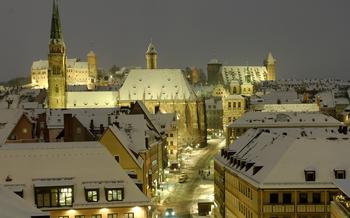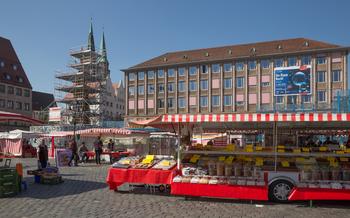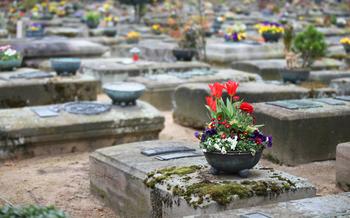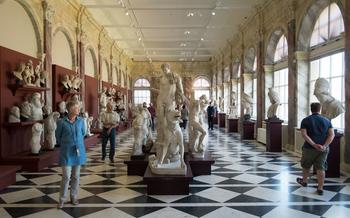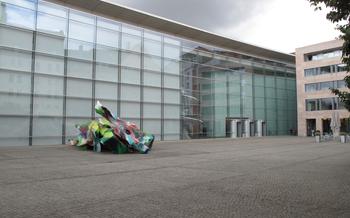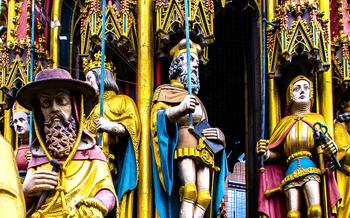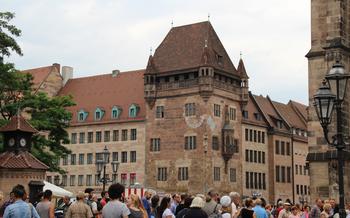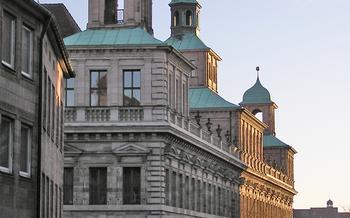
St. Sebaldus Church (Sebalduskirche)
- A Gothic Masterpiece in the Heart of Nuremberg
- Unveiling the History of St. Sebaldus
- Exploring the Architectural Splendor
- A Treasure Trove of Art and Artifacts
- The Shrine of St. Sebaldus
- The Sebaldus Organ: A Symphony of Sacred Sounds
- The Sebaldus Bells: A Symphony of History and Faith
- The Sebaldus Cemetery: A Haven of History and Remembrance
- Events and Services
- Combining History and Modernity
- The Sebaldus Treasure Chamber
- Legends and Folklore
- The Sebaldusmarkt
- Insider Tip: Unveiling the Hidden Gem of St. Sebaldus Church
A Gothic Masterpiece in the Heart of Nuremberg
In the heart of Nuremberg, a city steeped in history and architectural wonders, stands St. Sebaldus Church, a Gothic masterpiece that has witnessed centuries of devotion and played a pivotal role in the city's development. Its towering spires pierce the sky, beckoning visitors to explore its rich history, stunning architecture, and spiritual significance.
St. Sebaldus Church holds a prominent place in Nuremberg's religious landscape, serving as a spiritual center for both the city's inhabitants and pilgrims from afar. Dedicated to St. Sebaldus, the patron saint of Nuremberg, the church has been a site of worship and veneration for over a millennium.
The church's architectural style is a testament to the Gothic era's grandeur, with its intricate carvings, pointed arches, and soaring buttresses. Its construction began in the 13th century and continued for over 200 years, reflecting the dedication and craftsmanship of its builders.
Located in the heart of Nuremberg's historic center, St. Sebaldus Church is easily accessible by foot or public transportation. Its proximity to other notable landmarks, such as the Nuremberg Castle and the Hauptmarkt (main square), makes it a convenient stop on any walking tour of the city.
According to legend, the church's construction was initiated by St. Sebaldus himself, who appeared to a local builder in a dream and instructed him to build a church on the site where his remains were buried. This tale underscores the deep connection between St. Sebaldus and the church that bears his name, making it a cherished symbol of the city's rich religious heritage.
Unveiling the History of St. Sebaldus
St. Sebaldus, the patron saint of Nuremberg, was a 8th-century missionary who dedicated his life to spreading Christianity throughout the region. According to legend, he arrived in Nuremberg on a horse-drawn cart and, upon his death, was buried in the city. His tomb quickly became a place of pilgrimage, and a small chapel was built over it in the 11th century.
As Nuremberg grew in prominence during the Middle Ages, the chapel was expanded to accommodate the increasing number of pilgrims. In the 13th century, construction began on the current Gothic-style church, which was completed in the 15th century. Over the centuries, St. Sebaldus Church underwent several renovations and additions, reflecting the changing architectural styles and the growing importance of the church.
During the Holy Roman Empire, St. Sebaldus Church played a significant role in the city's religious and political life. It was here that the imperial regalia, including the crown jewels, were kept and displayed during important ceremonies. The church also served as a venue for imperial diets and other important events.
One famous historical figure associated with St. Sebaldus Church is Albrecht Dürer, the renowned Renaissance artist. Dürer was a devout Christian and often attended services at the church. He was also a close friend of the church's pastor, Willibald Pirckheimer, and is believed to have been buried in the church's cemetery.
Exploring the Architectural Splendor
The exterior of St. Sebaldus Church is a testament to the grandeur of Gothic architecture. Its twin towers, reaching towards the heavens, dominate the Nuremberg skyline. The intricate carvings and sculptures adorning the facades depict biblical scenes and figures, inviting visitors to delve into the stories they hold.
Stepping inside the church, one is immediately struck by the soaring nave, supported by slender columns that create a sense of spaciousness and lightness. The ribbed vaults overhead, a hallmark of Gothic design, converge at the center, drawing the eye upwards.
The choir, with its elaborate wooden stalls intricately carved with scenes from the life of Christ, is a masterpiece of craftsmanship. The stained glass windows, casting a kaleidoscope of colors onto the interior, depict biblical narratives and the lives of saints. Each window is a work of art in its own right, telling stories of faith, hope, and redemption.
One unique architectural element that sets St. Sebaldus Church apart is the "Schöne Tür," or Beautiful Door. Located on the south side of the church, this intricately carved portal features scenes from the life of the Virgin Mary and is considered one of the finest examples of Gothic sculpture in Germany.
Visitors often miss a hidden architectural detail in the church: a small, unassuming door tucked away in a corner. This is the "Sebalder Türlein," or Sebaldus Doorway, which leads to a spiral staircase ascending to the church's towers. Climbing the narrow steps rewards visitors with breathtaking panoramic views of Nuremberg, making it a must-do for those seeking a unique perspective of the city.
A Treasure Trove of Art and Artifacts
The St. Sebaldus Church is home to a remarkable collection of artworks and artifacts that reflect its rich history and religious significance. Among the most notable pieces is the bronze statue of St. Sebaldus, created by the renowned sculptor Peter Vischer the Elder in the 16th century. The statue depicts the patron saint in his bishop's robes, holding a model of the church in his hand. Its intricate details and lifelike features make it a masterpiece of the Renaissance period.
Another highlight is the Tucher Altar, a magnificent altarpiece carved from sandstone in the 15th century. The altar features intricate carvings depicting scenes from the life of Christ and the Virgin Mary. Its vibrant colors and expressive figures make it a stunning example of medieval craftsmanship.
The church also houses a collection of valuable tapestries, including the "Sebaldus Tapestry", which dates back to the 15th century. The tapestry depicts the life of St. Sebaldus and is considered one of the finest examples of its kind in Germany.
One fascinating anecdote about the artwork in the church is the story of the "Praying Hands", a pair of bronze sculptures depicting clasped hands in prayer. The sculptures were created by Albrecht Dürer, a famous German artist, and were originally intended for his own tomb. However, they were later acquired by the church and have become one of its most beloved and iconic pieces of art.
The Shrine of St. Sebaldus
The most revered and awe-inspiring feature of St. Sebaldus Church is undoubtedly the elaborate shrine dedicated to its patron saint. Crafted by the skilled hands of master craftsmen in the 15th century, the shrine stands as a testament to the city's devotion to St. Sebaldus and his enduring legacy.
The shrine is a masterpiece of Gothic art, adorned with intricate carvings, delicate tracery, and shimmering gold leaf. Its central focus is a silver reliquary, believed to contain the remains of St. Sebaldus himself. The reliquary is encased in a magnificent canopy, supported by slender columns and decorated with scenes from the saint's life.
The symbolism embedded in the shrine's design is profound. The intricate carvings depict biblical narratives and allegorical figures, each conveying a message of faith, hope, and redemption. The interplay of light and shadow, as sunlight filters through the stained glass windows, casts an ethereal glow upon the shrine, further enhancing its sacred aura.
Veneration of St. Sebaldus has played a pivotal role in the history of Nuremberg. Pilgrims from across Europe flocked to the city to pay homage to the saint and seek his intercession. The shrine became a symbol of the city's deep-rooted faith and a source of spiritual inspiration for its people. To this day, the shrine remains a sacred site, attracting countless visitors who come to marvel at its beauty and pay their respects to St. Sebaldus.
Anecdote:
Legend has it that during the construction of the shrine, a mysterious stranger appeared, offering his services as a metalworker. Despite his exceptional skills, the stranger remained anonymous, working tirelessly day and night until the shrine was completed. When the stranger vanished as suddenly as he had appeared, people believed it was St. Sebaldus himself, come to oversee the creation of his final resting place.
The Sebaldus Organ: A Symphony of Sacred Sounds
The Sebaldus Church is not only a testament to architectural grandeur but also a sanctuary for musical excellence. At the heart of the church's musical tradition lies the Sebaldus Organ, a magnificent instrument that has captivated audiences for centuries.
Crafted by renowned organ builder Hans Suess in the 15th century, the Sebaldus Organ is a masterpiece of engineering and artistry. Its imposing size, with over 6,000 pipes, fills the church's vast interior, creating a symphony of sacred sounds.
The organ's intricate carvings, adorned with biblical scenes and mythical creatures, reflect the Gothic style of the church. Its gilded pipes shimmer in the candlelight, adding to the awe-inspiring ambiance during religious services and concerts.
Over the centuries, the Sebaldus Organ has played a pivotal role in the church's musical heritage. Renowned organists have graced its keys, filling the sacred space with their virtuosic performances. The organ's versatility allows it to accompany both traditional hymns and complex classical compositions, creating a truly immersive musical experience.
One memorable performance that lingers in the annals of the church's history is a concert by the renowned organist Johann Sebastian Bach. In 1732, Bach visited Nuremberg and was invited to play the Sebaldus Organ. His improvisations and masterful interpretations left the audience spellbound, solidifying his reputation as one of the greatest organists of all time.
To this day, the Sebaldus Organ continues to enchant visitors with its celestial melodies. Whether accompanying religious services or showcasing the talents of world-renowned organists, this magnificent instrument remains an integral part of the church's vibrant musical legacy.
The Sebaldus Bells: A Symphony of History and Faith
The Sebaldus Church is not only renowned for its architectural splendor but also for its captivating bells that have been echoing through the streets of Nuremberg for centuries. These bells, housed in the church's distinctive bell tower, hold a significant place in the city's history and cultural heritage.
The oldest bell, known as the "Sebaldus Bell," was cast in 1356 and is considered one of the most significant bells in Germany. Weighing over six tons, it boasts an impressive diameter of 2 meters and produces a deep, resonant sound that can be heard from miles away.
The bell tower, a magnificent structure adorned with intricate carvings, houses a total of eight bells, each with its unique tone and purpose. The bells have traditionally been rung to mark important occasions, such as religious festivals, public holidays, and significant events in the city's history.
One of the most notable traditions associated with the Sebaldus bells is the "Noon Bell." Every day at noon, the bells chime in unison, creating a harmonious melody that reverberates through the streets of Nuremberg. This tradition dates back to the Middle Ages and served as a signal for the city's residents to pause their work and offer a prayer.
The Sebaldus bells have witnessed countless historical moments, from the bustling medieval markets to the tumultuous periods of war and conflict. They have rung to celebrate victories, mourn losses, and guide the faithful through centuries of religious devotion.
Anecdote:
In the annals of the Sebaldus bells, one story stands out as a testament to their enduring significance. During World War II, when Nuremberg faced relentless air raids, the bells were removed from the tower to protect them from damage. Miraculously, they survived the war unscathed and were returned to their rightful place after the conflict ended. The sound of the bells ringing once again over the war-torn city was a symbol of hope and renewal for the people of Nuremberg.
The Sebaldus Cemetery: A Haven of History and Remembrance
Surrounding the majestic St. Sebaldus Church lies a tranquil haven known as the Sebaldus Cemetery. This historic burial ground has served as the final resting place for countless notable figures who have contributed to Nuremberg's rich history and culture. As you wander through its serene paths, you'll encounter a fascinating tapestry of gravestones and monuments, each telling a unique story.
Among the most prominent figures buried here is Albrecht Dürer, the renowned Renaissance artist whose works continue to captivate art enthusiasts worldwide. His grave, adorned with an elaborate epitaph, pays homage to his artistic genius and enduring legacy.
Another notable resident of the Sebaldus Cemetery is Veit Stoss, a renowned sculptor whose intricate wood carvings grace many churches and public spaces in Nuremberg. His own tombstone, a testament to his mastery, showcases his exceptional craftsmanship and attention to detail.
As you explore the cemetery further, you'll discover the graves of other influential individuals who have shaped Nuremberg's destiny. Merchants, scholars, politicians, and religious leaders all lie side by side, their stories interwoven with the fabric of the city's past.
One particularly poignant tale associated with the Sebaldus Cemetery is that of Maria Sibylla Merian, a pioneering naturalist and artist. Her grave, marked by a simple stone, belies the extraordinary contributions she made to the fields of entomology and botany. Her detailed illustrations of insects and plants continue to inspire scientists and artists alike.
The Sebaldus Cemetery is not merely a place of mourning but also a site of remembrance and celebration. The stories etched into the gravestones serve as a reminder of the lives and achievements of those who have gone before us, leaving an indelible mark on Nuremberg's history.
Events and Services
St. Sebaldus Church is not only a historical monument but also a vibrant center for religious and cultural events. Throughout the year, the church hosts a variety of services, concerts, exhibitions, and festivals that attract both locals and visitors.
Regular masses are held daily, providing an opportunity for worship and spiritual reflection. The church's impressive acoustics and beautiful surroundings create a truly immersive experience for attendees. Special services, such as Christmas Eve mass or Easter Sunday service, are particularly popular and draw large crowds.
In addition to religious services, St. Sebaldus Church is renowned for its musical tradition. The church's magnificent organ, the Sebaldus Organ, is a masterpiece of craftsmanship and produces a truly awe-inspiring sound. Regular organ concerts are held, showcasing the talents of renowned organists and featuring a diverse repertoire of classical and contemporary music.
The church also hosts a variety of exhibitions and events throughout the year. These exhibitions often showcase religious art, historical artifacts, or contemporary works inspired by the church's unique atmosphere. Visitors can explore these exhibitions to gain a deeper understanding of the church's history and significance.
One of the most popular events held at St. Sebaldus Church is the annual Sebaldusfest. This festival, held in honor of the church's patron saint, features a week-long program of events, including concerts, processions, and historical reenactments. The festival culminates in a grand procession through the streets of Nuremberg, where thousands of people gather to celebrate the life and legacy of St. Sebaldus.
Participating in events and services at St. Sebaldus Church is a wonderful way to experience the church's vibrant atmosphere and connect with its rich history and cultural significance. Whether you attend a mass, a concert, an exhibition, or a festival, you are sure to be captivated by the beauty and spirituality of this remarkable church.
Anecdote:
During one of the Sebaldusfest celebrations, a group of visitors from a distant land were particularly captivated by the beautiful music and festive atmosphere. They had never experienced anything quite like it before and were deeply moved by the sense of community and joy that permeated the event. They returned to their home country with fond memories of their time at St. Sebaldus Church and vowed to one day return for another Sebaldusfest celebration.
Combining History and Modernity
St. Sebaldus Church stands as a testament to the enduring spirit of Nuremberg, seamlessly blending its rich history with the advancements of the modern era. The church actively embraces technology to enhance the visitor experience, providing virtual tours, digital guides, and interactive displays that bring its history and significance to life.
Moreover, St. Sebaldus is committed to sustainable practices, reducing its environmental impact through energy-efficient lighting, recycling programs, and green initiatives. By adopting these modern approaches, the church demonstrates its commitment to preserving its heritage while embracing the future.
An anecdote that exemplifies this fusion of history and modernity is the recent installation of a state-of-the-art sound system. This system allows for superior acoustics during concerts and religious services, enhancing the immersive experience for visitors. It also enables live broadcasts of events, extending the church's reach to a global audience.
St. Sebaldus Church stands as a beacon of innovation, demonstrating how historic landmarks can adapt to the changing times while preserving their essence. It serves as an inspiration to other religious and cultural institutions, showcasing the power of embracing modernity to enhance the visitor experience and ensure the enduring relevance of heritage sites.
The Sebaldus Treasure Chamber
Nestled within the walls of St. Sebaldus Church lies a hidden treasure – the Sebaldus Treasure Chamber. This museum-like space is a testament to the church's rich history and houses a collection of invaluable artifacts and religious treasures. Among the highlights is the Sebaldus Shrine, a masterpiece of goldsmithing that holds the relics of the church's patron saint. Visitors can admire its intricate carvings, precious stones, and enamel work, which narrate the life and miracles of St. Sebaldus.
Other notable treasures include the Sebaldus Cross, a beautifully crafted processional cross adorned with gemstones and enamel, and the Sebaldus Sword, a symbol of the saint's authority and power. The collection also features exquisite liturgical vestments, chalices, reliquaries, and illuminated manuscripts, each telling a unique story of the church's past.
A visit to the Sebaldus Treasure Chamber is a journey through time, offering a glimpse into the artistry, devotion, and craftsmanship that have shaped St. Sebaldus Church. It's a must-see for anyone interested in religious history, art, or the rich heritage of Nuremberg.
Legends and Folklore
St. Sebaldus Church is steeped in myths, legends, and folklore that have captivated the imaginations of locals and visitors alike for centuries. One of the most enduring tales is that of the church's construction. Legend has it that Sebaldus himself appeared to the city's leaders in a dream, instructing them to build a church on the site of his hermitage. Skeptical at first, they hesitated until Sebaldus appeared again, this time leaving a footprint as proof of his divine intervention. The footprint, deeply embedded in a stone, can still be seen today, serving as a reminder of the miraculous origins of the church.
Another popular legend is that of the "Sebaldus Goose." According to the tale, a goose mysteriously appeared during the construction of the church, carrying a golden coin in its beak. The goose dropped the coin at the feet of the workers, who took it as a sign from God that the church would be built successfully. The goose became a symbol of divine favor and protection, and its image can be found throughout the church, including a statue on the exterior and a stained glass window inside.
The Sebaldusmarkt
The festive spirit of Christmas comes alive in Nuremberg with the annual Sebaldusmarkt, a traditional Christmas market held in the enchanting surroundings of St. Sebaldus Church. The market transforms the church's vicinity into a magical winter wonderland, filled with the sights, sounds, and aromas of the season.
Wooden stalls adorned with twinkling lights and festive decorations line the cobblestone streets, offering an array of traditional crafts, handmade gifts, and delectable treats. The air is filled with the sweet scent of roasted almonds, gingerbread, and mulled wine, creating an irresistible ambiance that draws visitors from near and far.
Stroll through the market and discover unique treasures, from hand-blown glass ornaments and wooden toys to intricate nativity scenes and festive textiles. Local artisans showcase their skills, offering a glimpse into the region's rich craftsmanship.
In addition to shopping, the Sebaldusmarkt offers a variety of special events, concerts, and activities that capture the spirit of the season. Enjoy the melodious sounds of Christmas carols sung by local choirs, or marvel at the intricate ice sculptures that adorn the market square.
As the sun sets and darkness envelops the city, the Sebaldusmarkt takes on a new charm. The twinkling lights illuminate the church's majestic facade, casting a warm glow over the festive stalls. Savor the magical atmosphere as you sip on a cup of hot mulled wine and indulge in the delicious culinary delights on offer.
Whether you're a local or a visitor, the Sebaldusmarkt is an unmissable experience that captures the essence of Nuremberg's Christmas traditions. Immerse yourself in the festive spirit, soak up the enchanting atmosphere, and create lasting memories in this enchanting winter wonderland.
Insider Tip: Unveiling the Hidden Gem of St. Sebaldus Church
Beyond the grandeur of St. Sebaldus Church, there lies a hidden gem waiting to be discovered. For those seeking a unique and immersive experience, venture into the church's tranquil courtyard, tucked away from the bustling city streets. Here, you'll find the exquisite Sebaldus Well, a beautifully preserved medieval structure dating back to the 14th century. Admire the intricate carvings adorning the wellhead, depicting scenes from the life of St. Sebaldus. As you gaze into the well's crystal-clear waters, let your imagination transport you back in time to an era of knights, pilgrims, and whispered secrets. This hidden gem offers a serene respite amidst the vibrant energy of Nuremberg, inviting you to pause, reflect, and connect with the rich history that permeates the very heart of this magnificent church.
